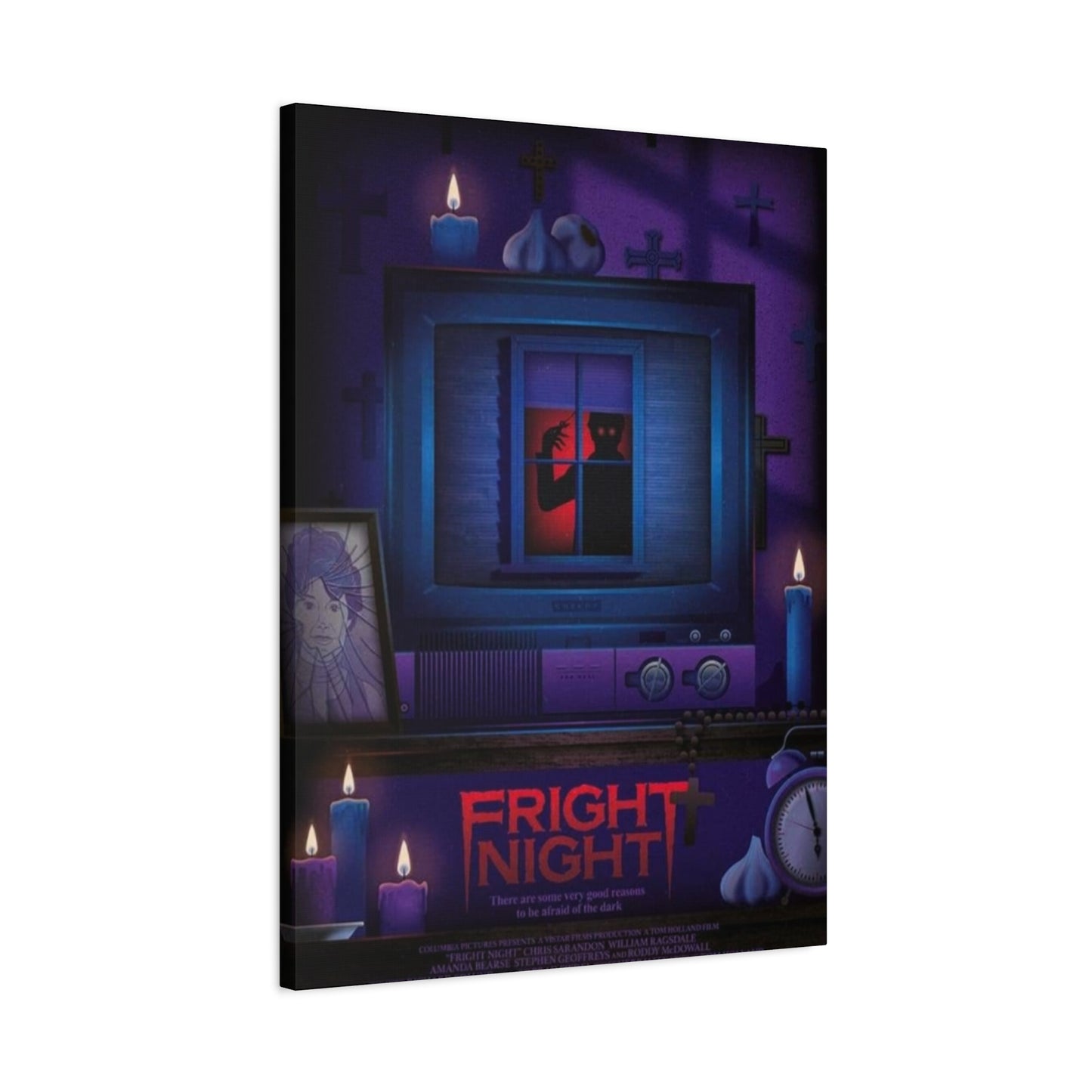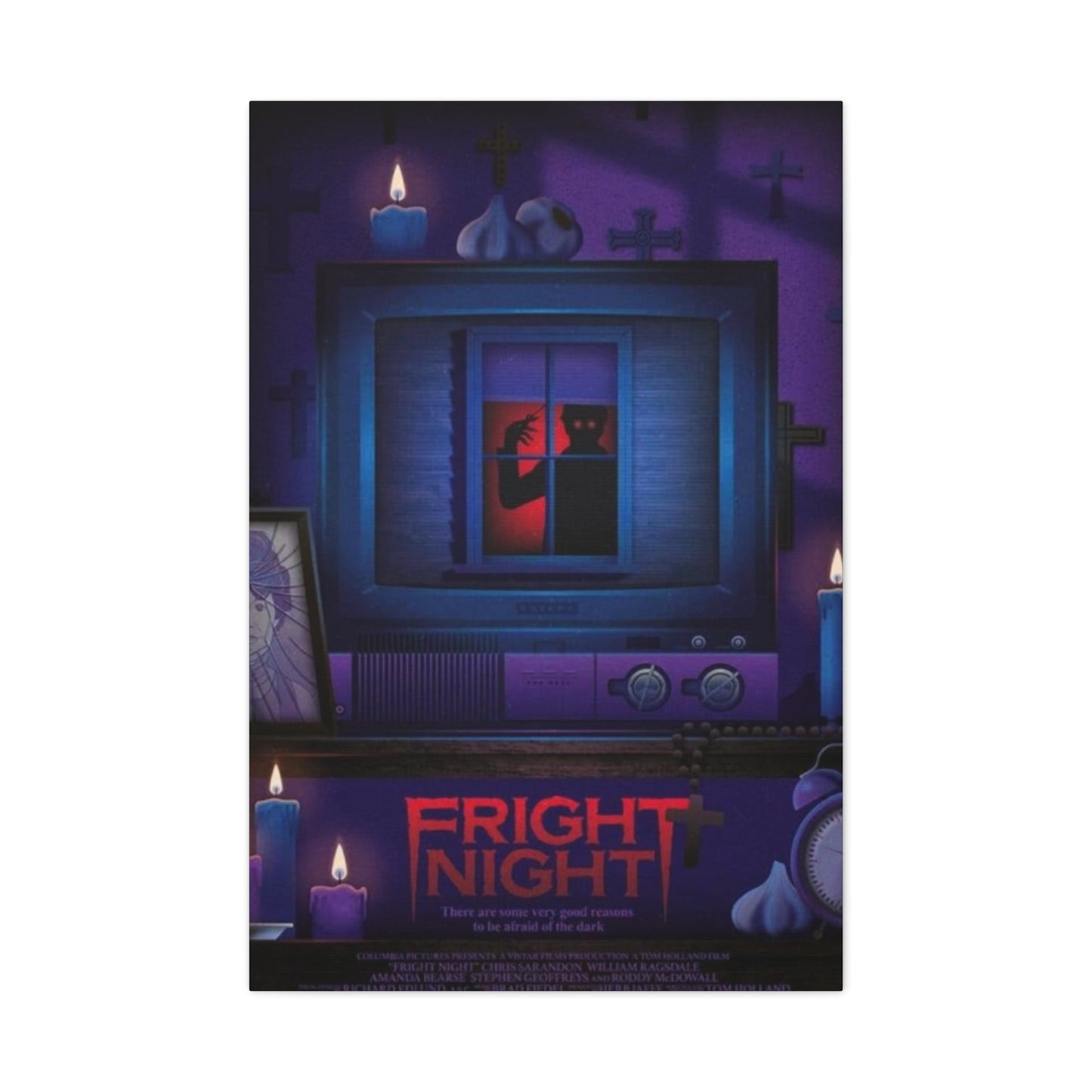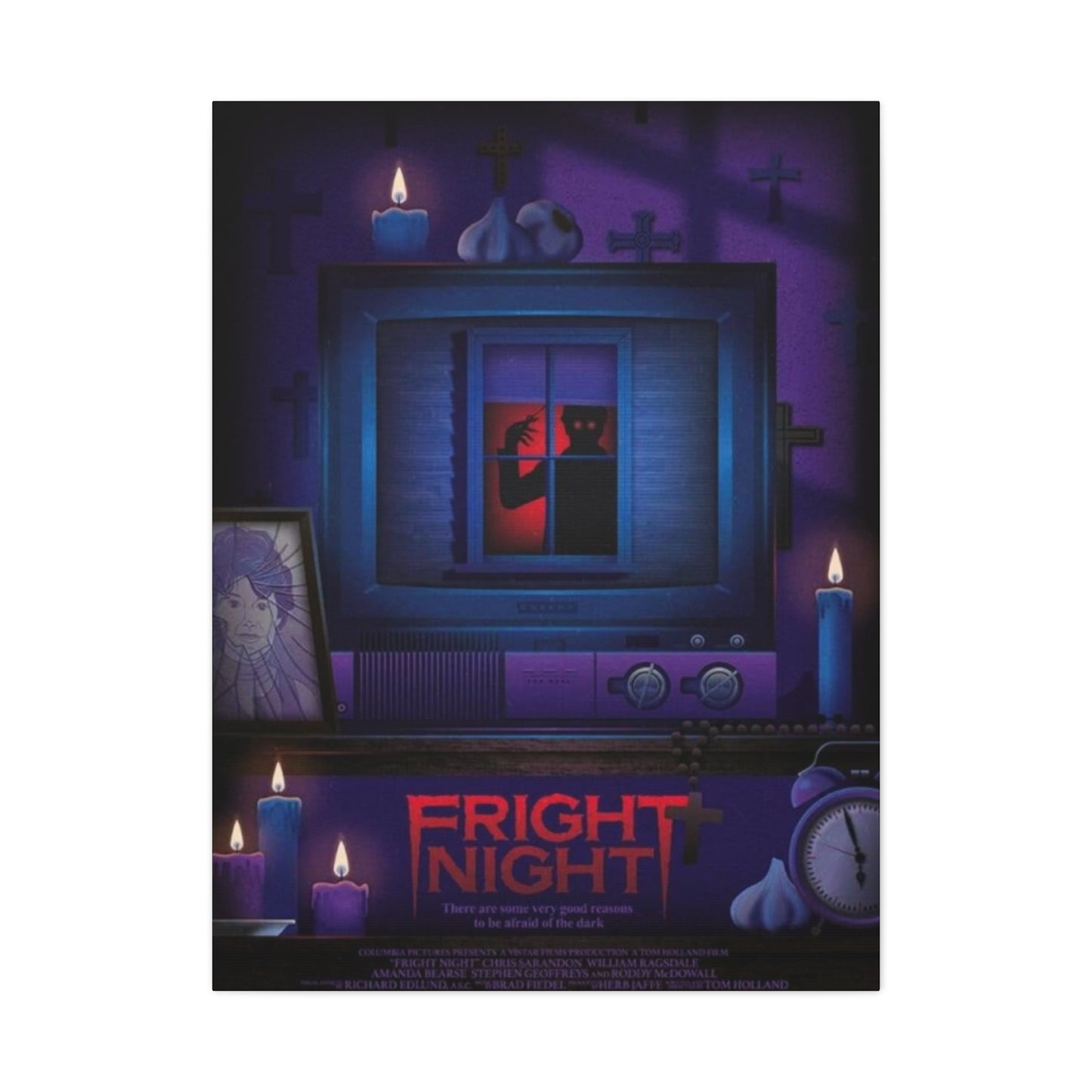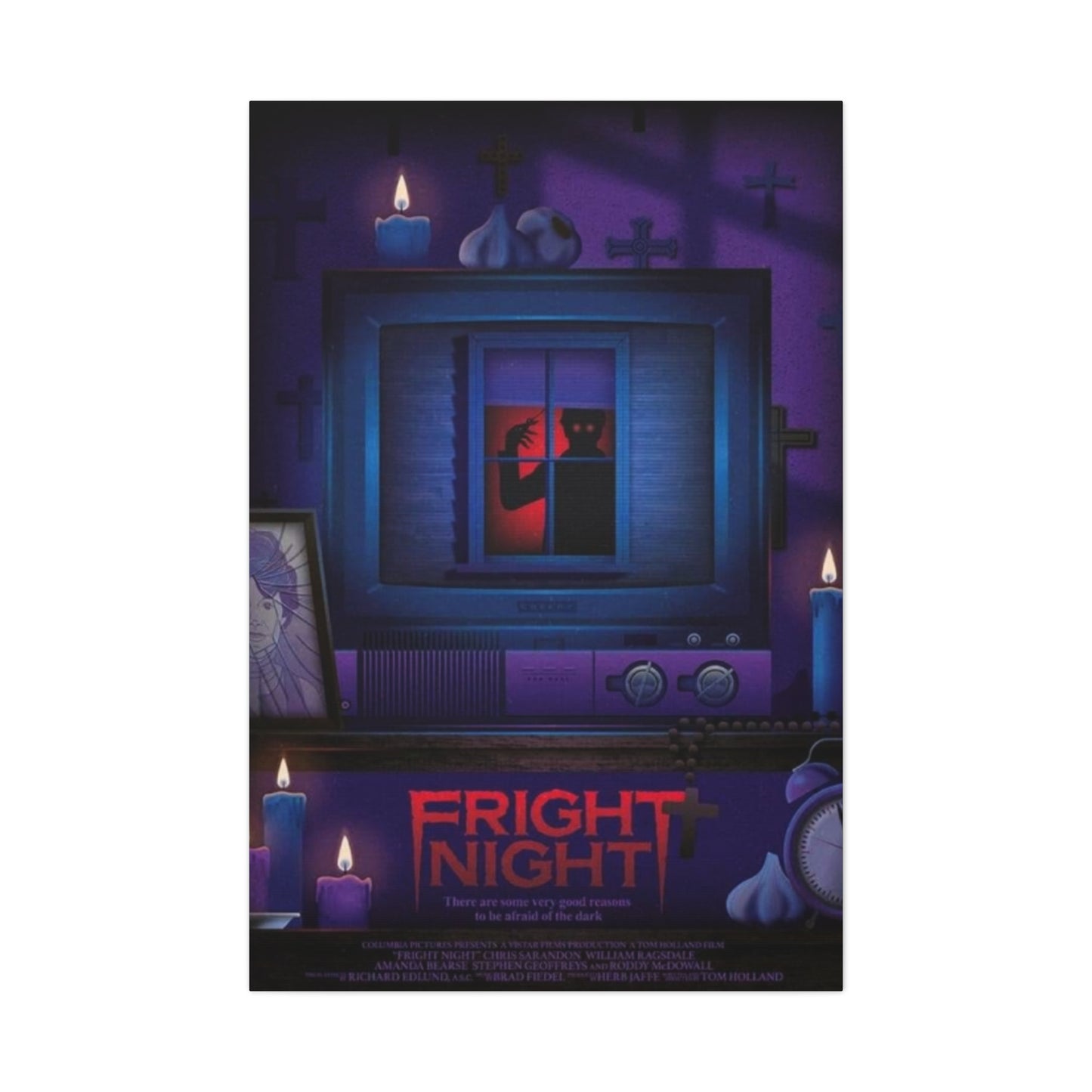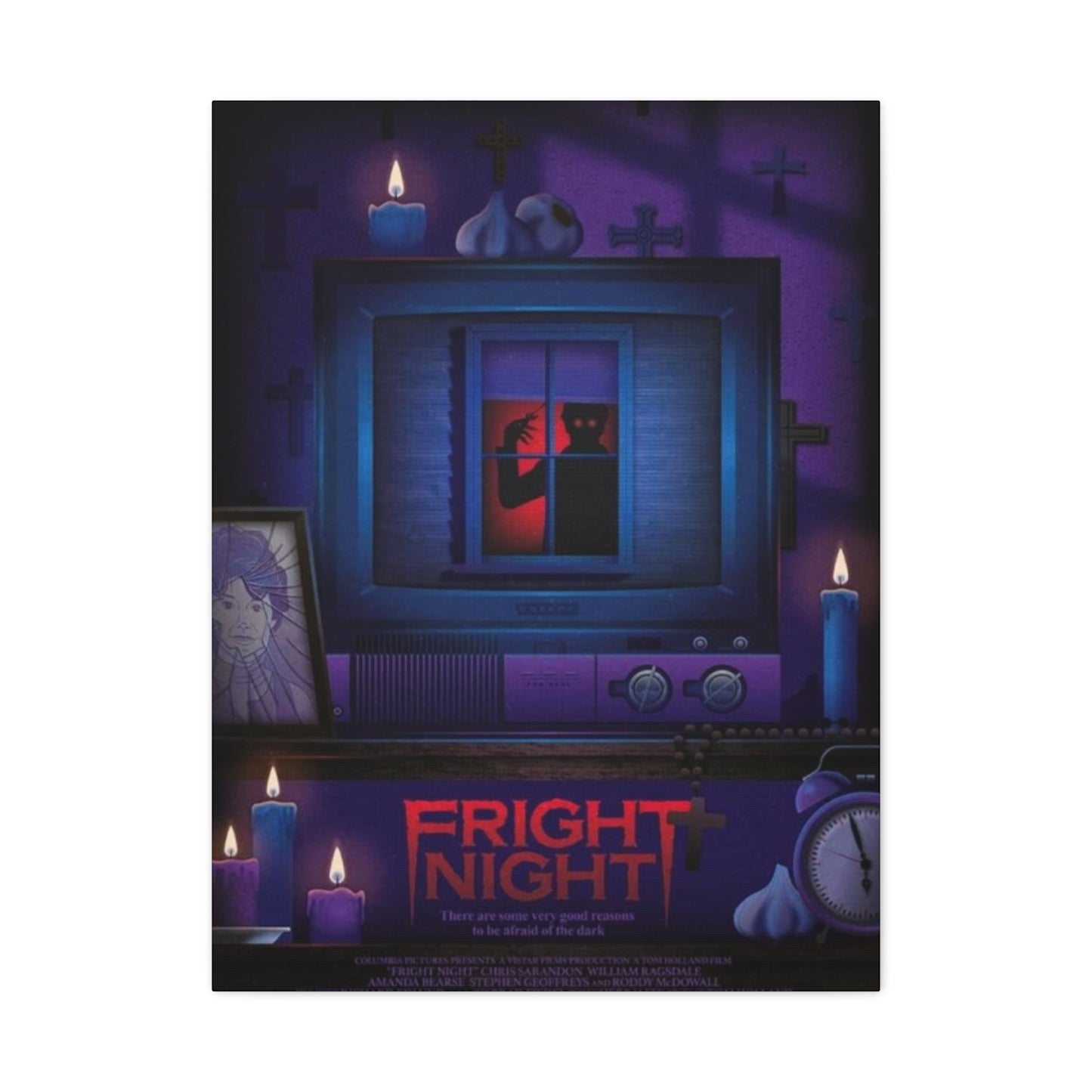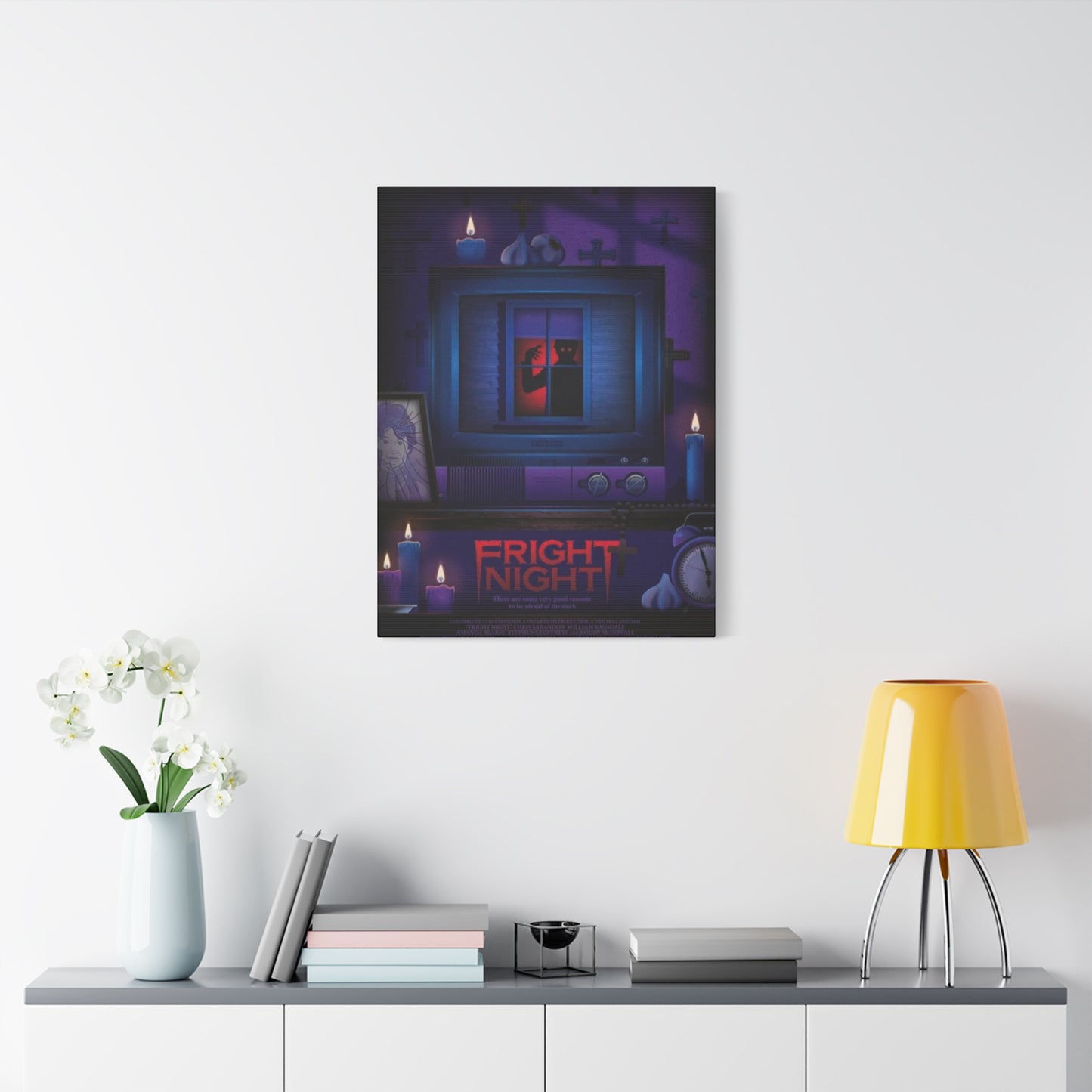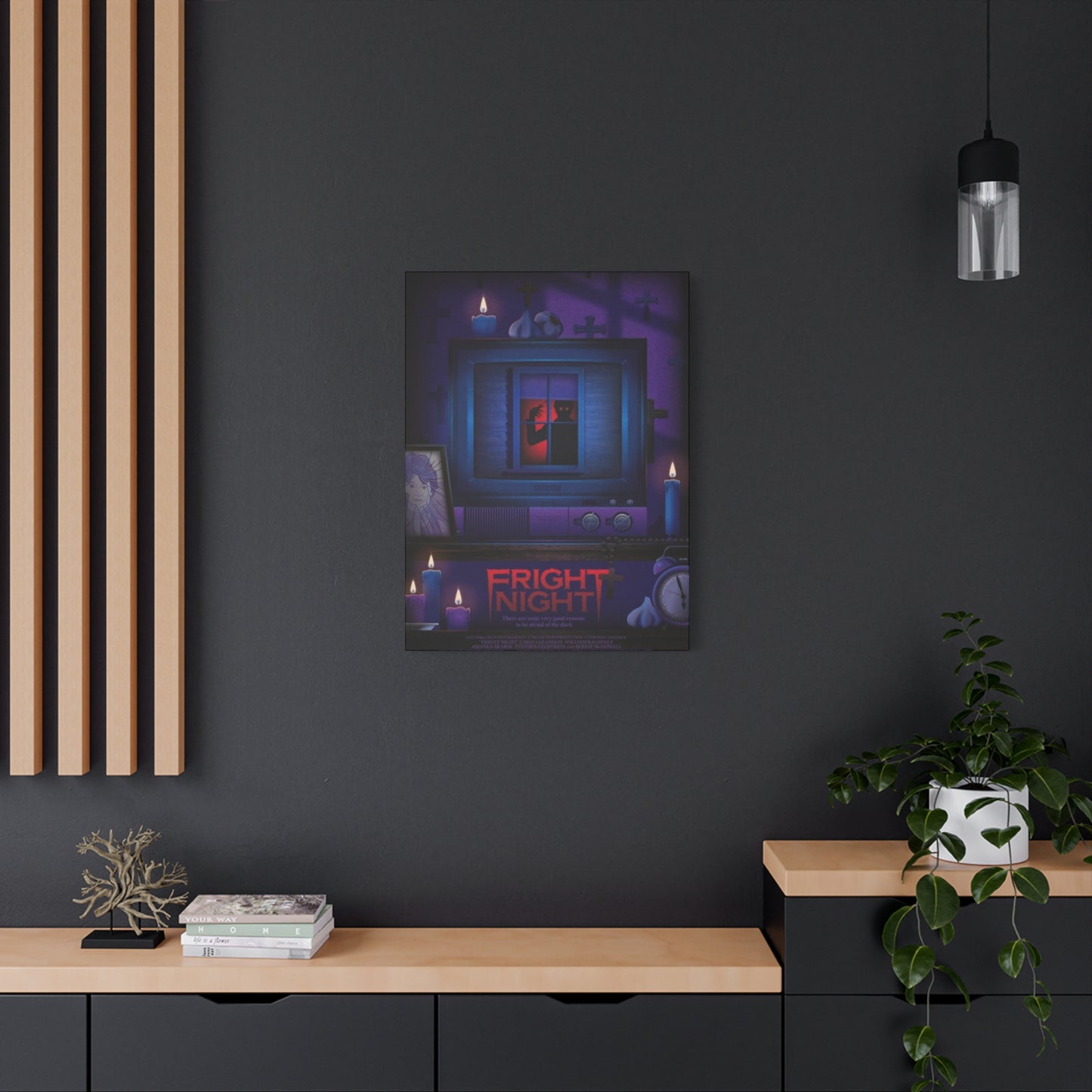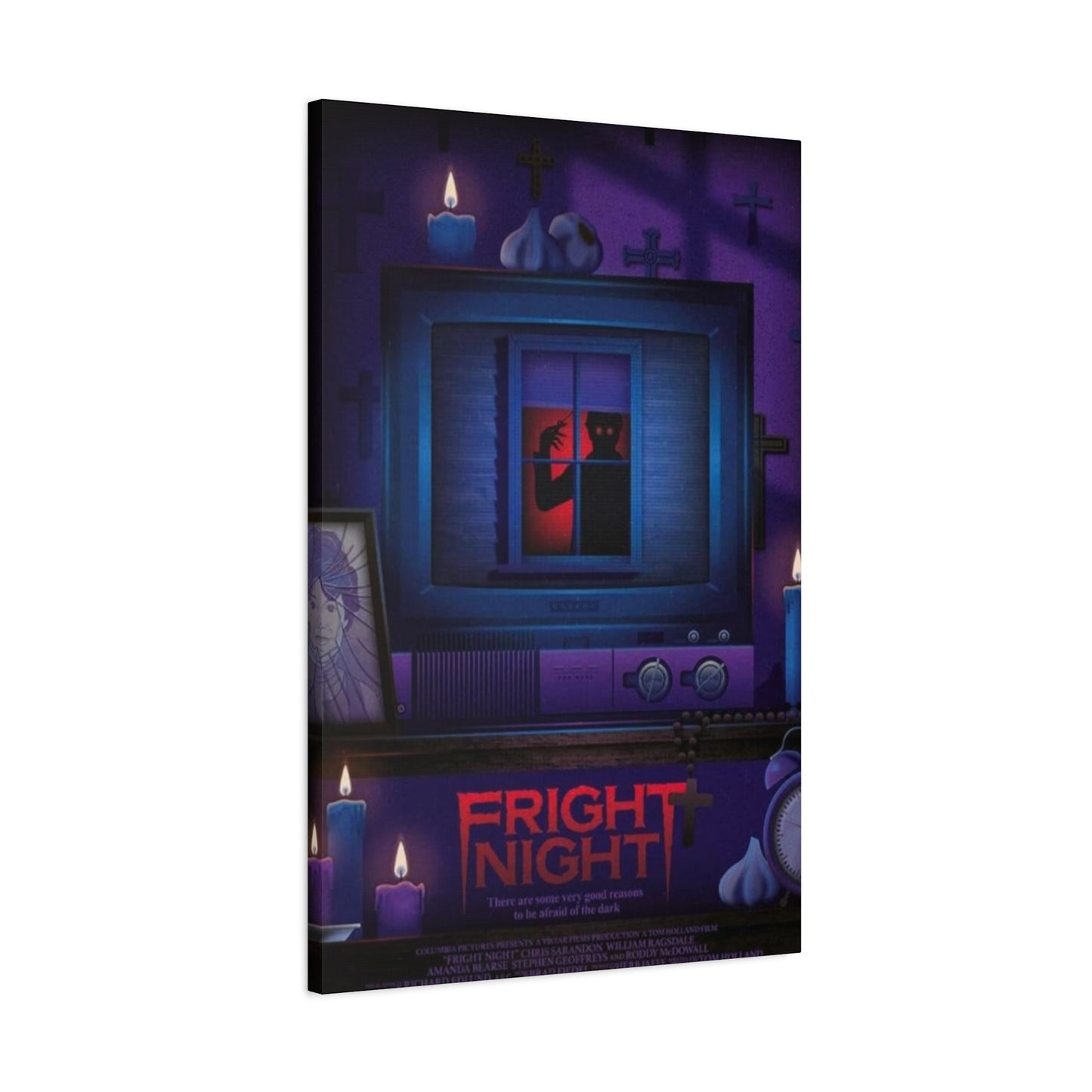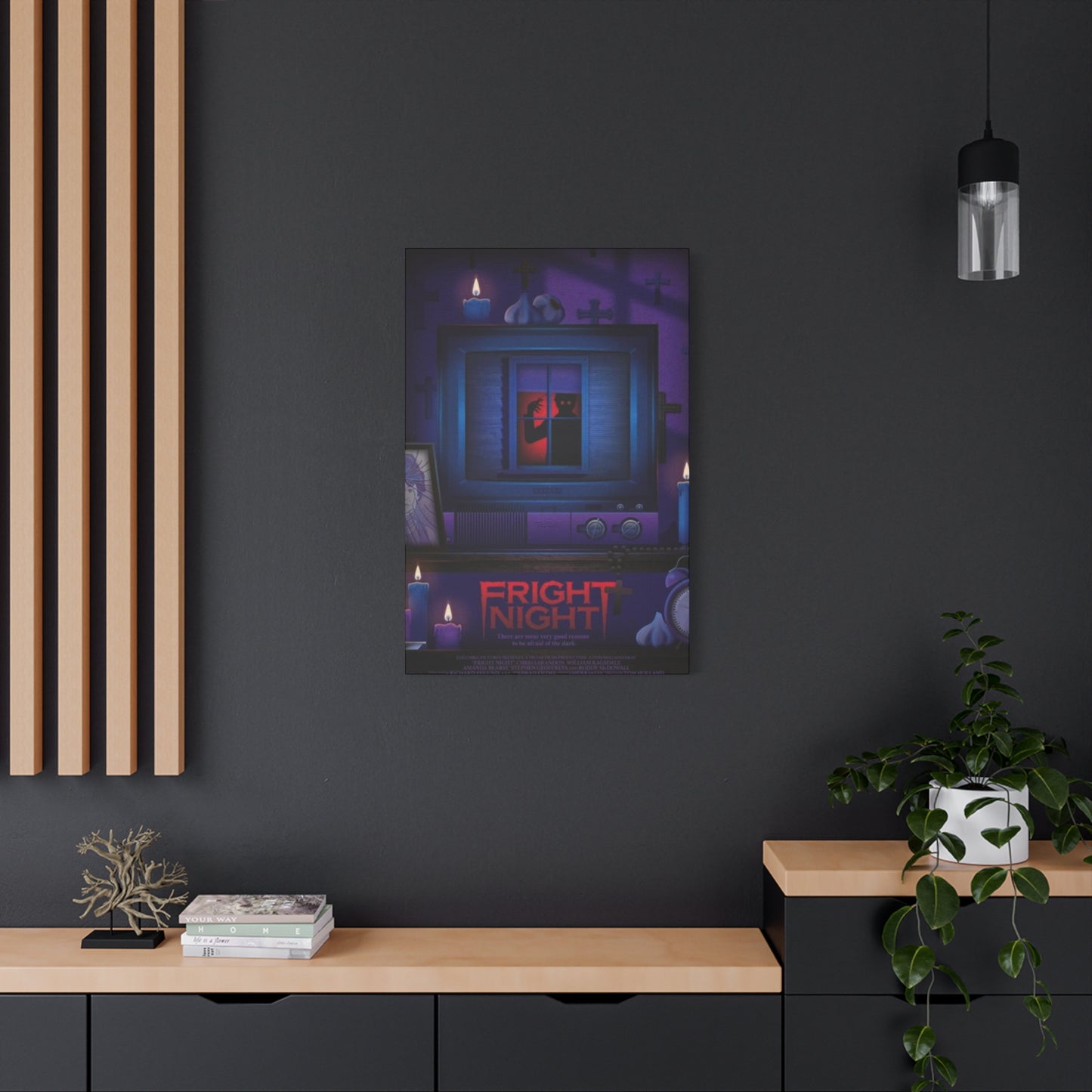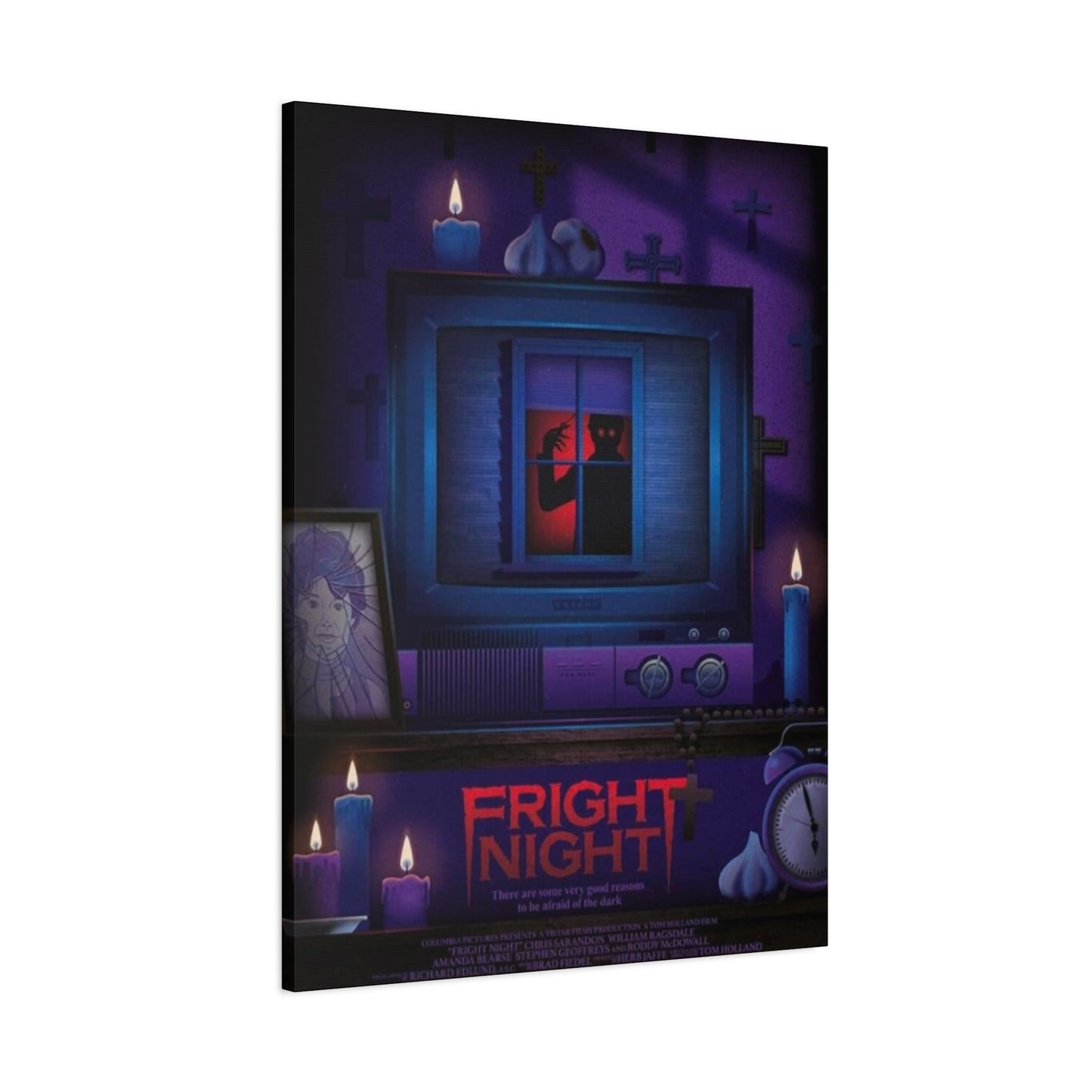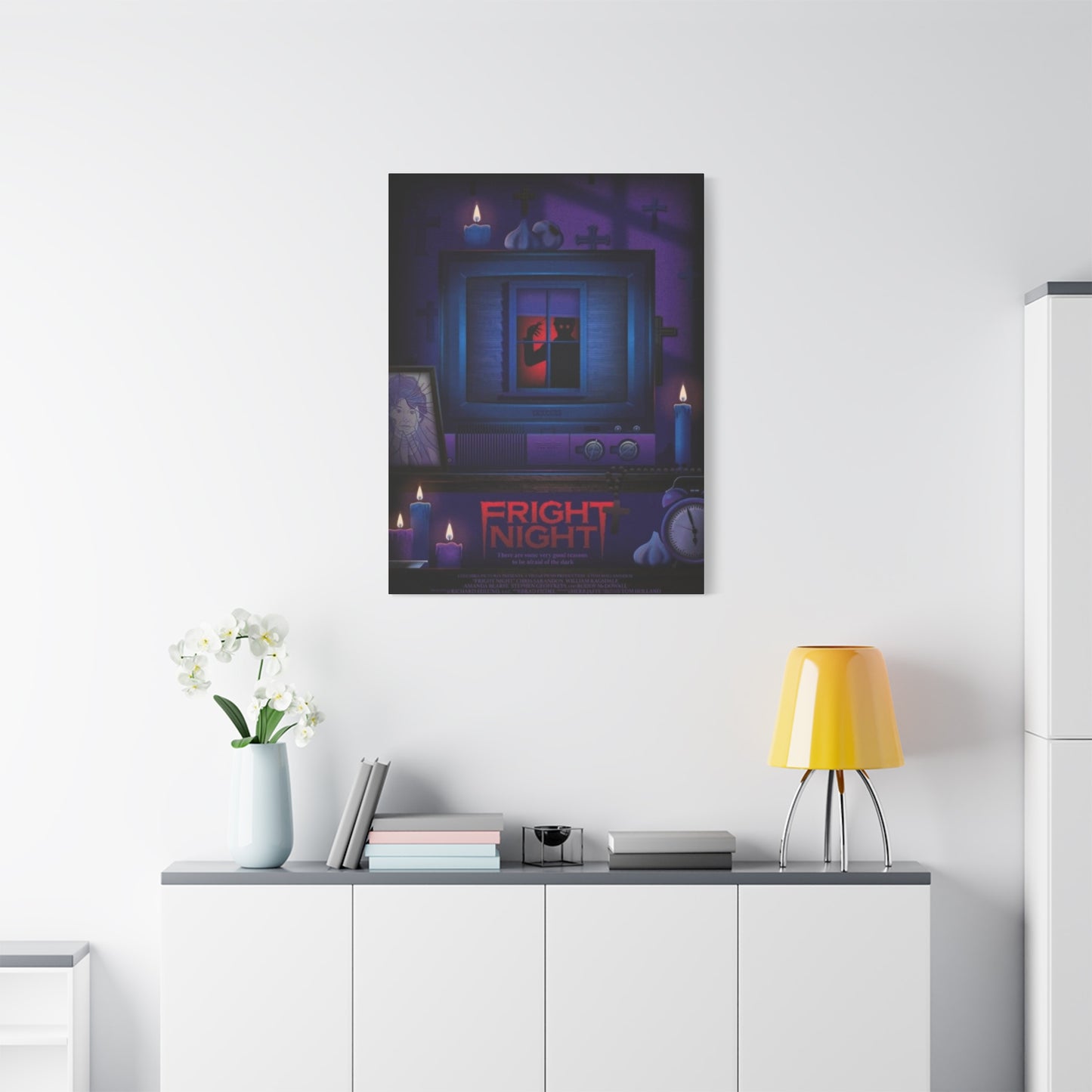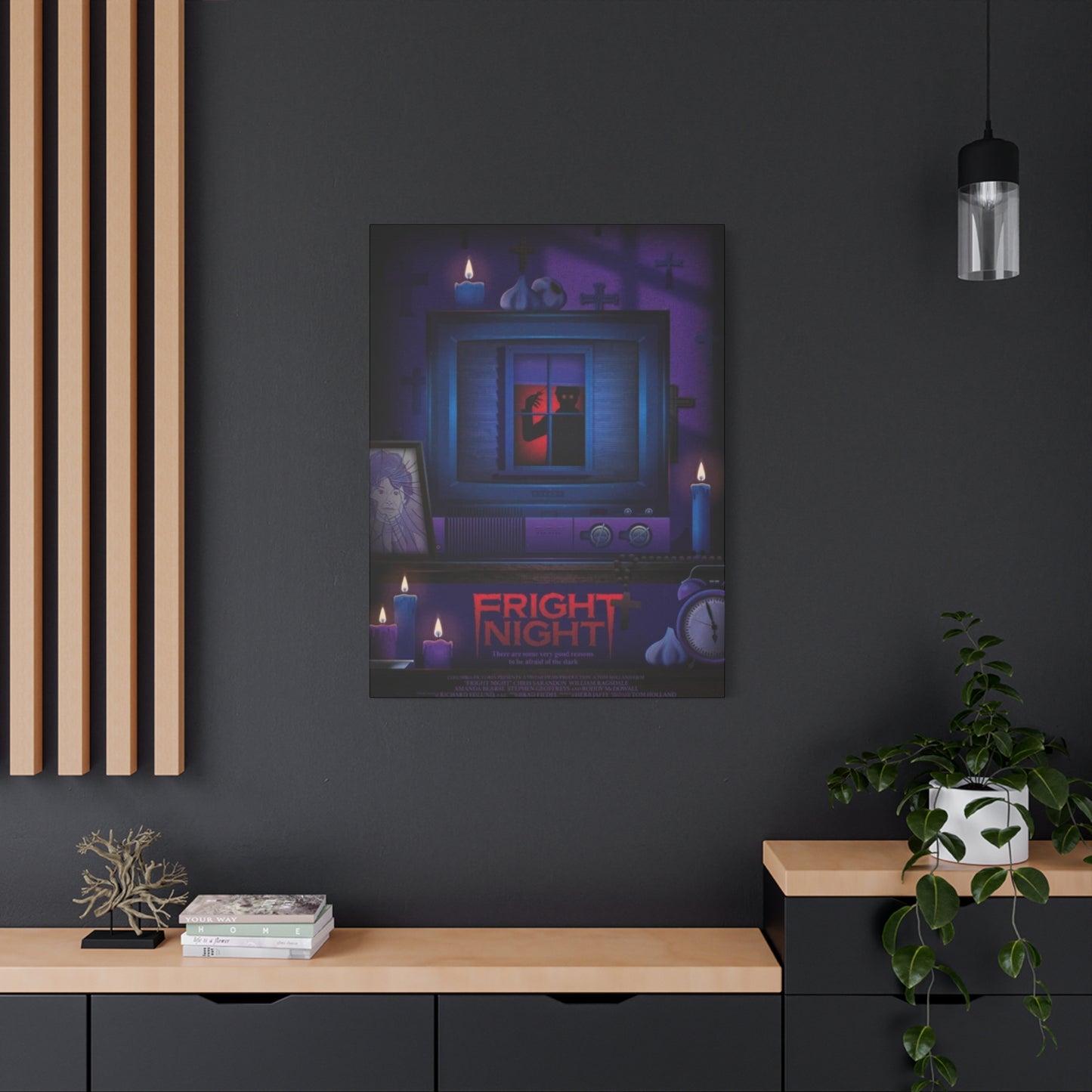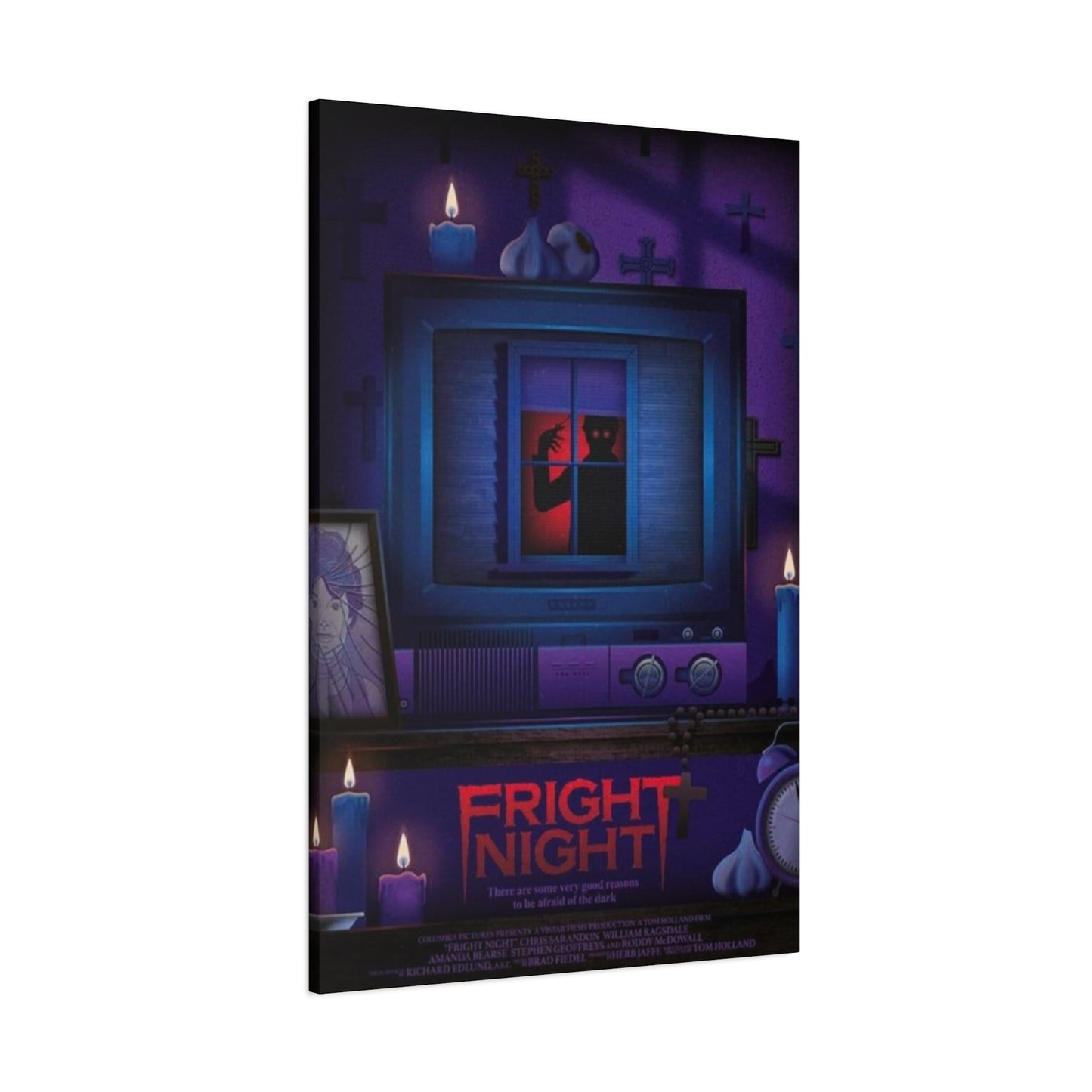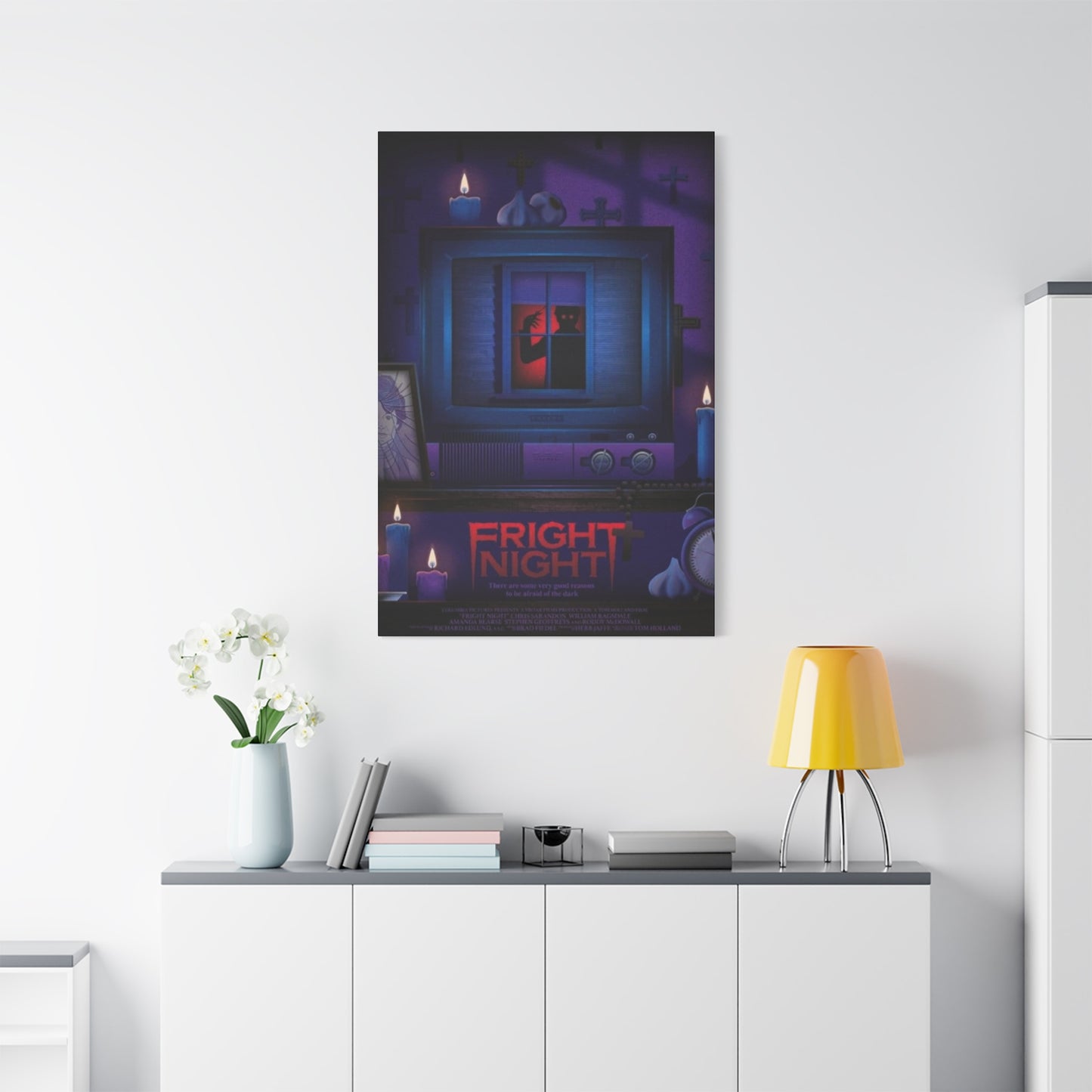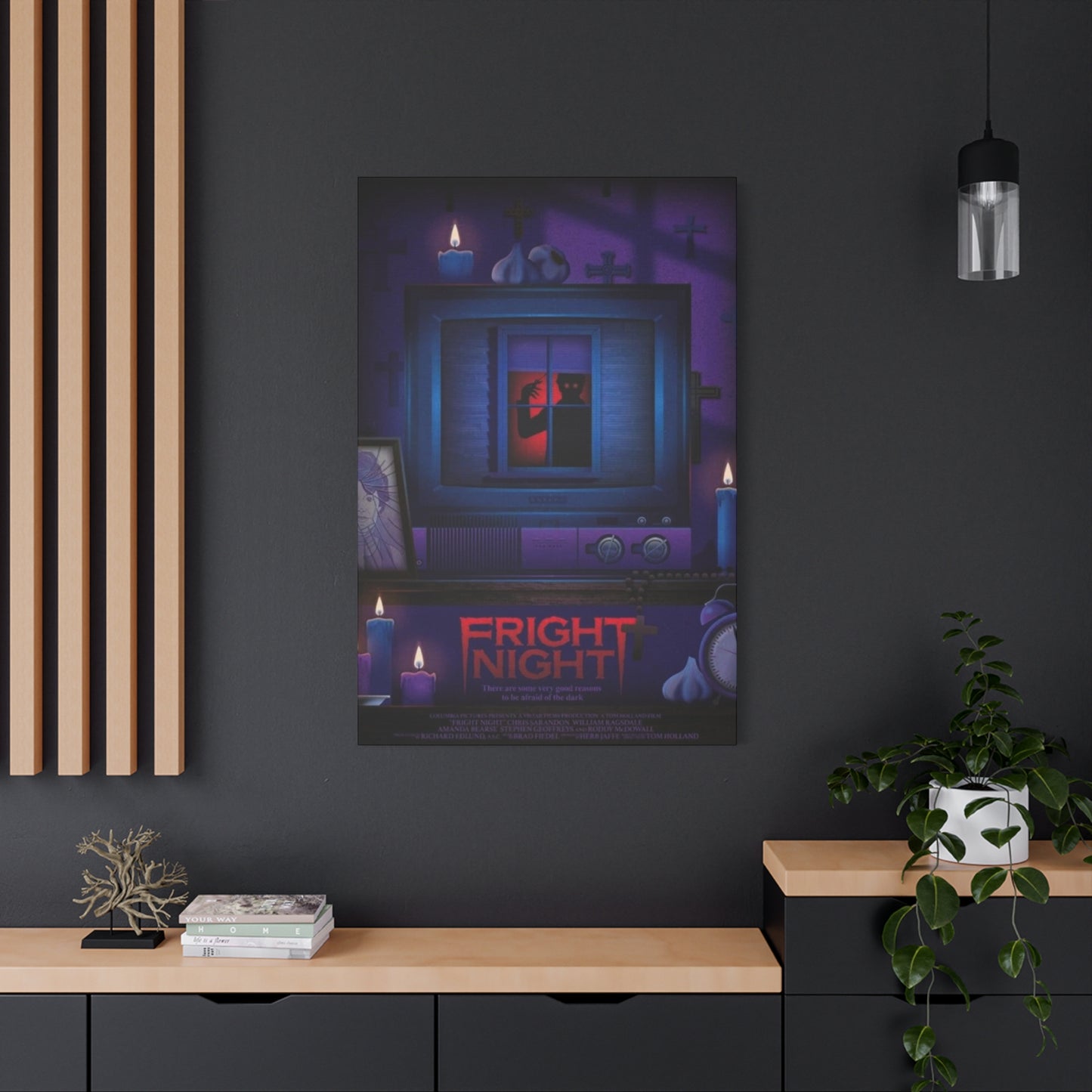Gothic Elegance and Horror: The Allure of Fright Night Wall Art
The allure of supernatural cinema has captivated audiences for decades, with vampire films holding a particularly special place in the hearts of horror enthusiasts. Among these cinematic treasures, one particular 1985 masterpiece stands out as a beacon of perfect horror-comedy balance, spawning a devoted following that extends far beyond the silver screen. This cult phenomenon has transcended its original medium, inspiring countless artistic interpretations that now grace the walls of homes worldwide.
When examining the cultural impact of vampire cinema, few films have managed to strike the delicate balance between genuine scares and clever humor quite like this beloved 80s classic. The movie's unique blend of traditional vampire mythology with suburban American life created a fresh take on the genre that resonated with audiences both then and now. This enduring appeal has naturally led to a thriving market for related artistic reproductions and decorative pieces.
The transformation of cinematic imagery into home decor represents a fascinating intersection of popular culture and personal expression. Homeowners who choose to display horror-themed artwork are making a statement about their appreciation for the genre while simultaneously creating atmospheric environments that reflect their individual tastes. This trend has particularly gained momentum in recent years as people seek to personalize their living environments with items that hold personal significance and cultural relevance.
The appeal of vampire-themed decorative elements extends beyond mere fandom. These pieces often incorporate rich color palettes, dramatic lighting effects, and gothic aesthetic elements that can enhance the visual appeal of various room settings. The artistic merit of well-designed horror movie reproductions often rivals that of traditional art forms, making them suitable for sophisticated home environments.
Contemporary interior styling has embraced the concept of eclectic mixing, where traditional design elements coexist harmoniously with pop culture references. This evolution in decorating philosophy has opened new avenues for incorporating themed artwork into mainstream home environments. The key lies in understanding how to balance these bold statements with complementary design elements to create cohesive and visually appealing living areas.
The craftsmanship involved in creating high-quality reproductions of horror cinema artwork demands attention to detail, color accuracy, and print quality. Professional-grade materials and printing techniques ensure that these pieces maintain their visual impact over time while resisting common issues such as fading, warping, or deterioration. This commitment to quality elevates horror-themed artwork from novelty items to legitimate decorative investments.
Embracing Retro Horror Aesthetics Through Classic Movie Imagery
The distinctive visual style of 1980s horror cinema represents a unique artistic movement that combined practical effects, atmospheric lighting, and bold graphic design sensibilities. This era produced some of the most iconic imagery in horror history, characterized by rich color palettes, dramatic contrasts, and memorable character designs that continue to influence contemporary artists and filmmakers.
The aesthetic appeal of retro horror imagery lies in its ability to evoke nostalgia while maintaining genuine artistic merit. The careful composition of these classic movie scenes, combined with the technical limitations of the era, resulted in a distinctive visual language that feels both timeless and specifically rooted in its cultural moment. This dual quality makes such imagery particularly suitable for home decoration, as it provides both conversational interest and visual sophistication.
When incorporating vintage horror elements into modern living environments, the key is understanding how these pieces can complement contemporary design trends. The bold graphics and saturated colors typical of 80s horror posters can serve as striking focal points in minimalist room settings, while their nostalgic qualities add warmth and personality to otherwise sterile modern aesthetics.
The cultural significance of retro horror extends beyond mere entertainment value. These films and their associated imagery represent important moments in cinematic history, documenting the evolution of storytelling techniques, special effects technology, and cultural attitudes toward fear and entertainment. Displaying such artwork demonstrates an appreciation for this cultural heritage while contributing to its preservation and continued relevance.
The craftsmanship evident in classic horror movie poster design reflects the golden age of hand-drawn illustration and traditional graphic design techniques. Before the advent of digital design tools, artists relied on traditional media to create compelling promotional materials, resulting in artwork that possesses a tactile quality and human touch often missing from contemporary digital creations.
Modern reproductions of vintage horror artwork benefit from advances in printing technology that can capture the subtle gradations and rich textures of original illustrations with unprecedented accuracy. High-resolution scanning and professional-grade printing ensure that contemporary versions maintain the visual impact and artistic integrity of their source materials while providing the durability needed for long-term display.
The psychological impact of vintage horror imagery in home environments creates an intriguing dynamic between comfort and excitement. These pieces can add an element of playful danger to familiar surroundings, creating conversation starters and memorable impressions for guests while reflecting the homeowner's appreciation for genre cinema and artistic expression.
Atmospheric Enhancement Through Gothic Cinema Prints
The power of cinematic artwork to transform ordinary living environments into atmospheric sanctuaries cannot be understated. Gothic horror imagery, with its emphasis on mood, shadow, and psychological tension, offers unique opportunities for creating immersive home environments that engage the senses and stimulate the imagination.
The visual elements common to gothic horror cinema translate exceptionally well to home decor applications. Deep, rich color schemes featuring burgundy, midnight blue, and charcoal create sophisticated color palettes that work beautifully with traditional and contemporary furnishing styles. The dramatic lighting effects captured in these cinematic moments can add depth and visual interest to flat wall surfaces while creating focal points that draw the eye and create visual hierarchy within room layouts.
Understanding the emotional impact of gothic imagery is crucial for successful implementation in residential settings. While these pieces often depict supernatural or frightening subjects, their artistic treatment and cultural context transform them into acceptable, even desirable, decorative elements. The key lies in selecting images that balance their dramatic content with artistic sophistication and cultural significance.
The architectural elements often featured in gothic horror films provide excellent inspiration for home decorating themes. Ornate doorways, shadowy corridors, and atmospheric lighting effects can inspire complementary design choices in furniture selection, lighting design, and architectural details. This creates opportunities for developing cohesive decorative schemes that extend beyond individual artwork pieces.
The storytelling aspect of gothic horror imagery adds narrative depth to home environments. Unlike abstract or purely decorative artwork, these pieces carry inherent stories and cultural associations that can spark conversations and create memorable experiences for residents and guests alike. This narrative quality makes them particularly effective in entertainment areas and social gathering spots.
Professional framing and presentation techniques can significantly enhance the impact of gothic horror artwork. Appropriate matting, frame selection, and lighting can transform movie stills or promotional images into museum-quality displays that command respect and attention. The investment in quality presentation materials pays dividends in terms of both aesthetic impact and long-term preservation.
The versatility of gothic horror imagery allows for creative applications beyond traditional framed displays. These images can inspire decorative themes that extend to textiles, lighting fixtures, and architectural elements, creating immersive environments that fully embrace the gothic aesthetic while maintaining livability and comfort.
Cultural Icon Status and Artistic Recognition
The elevation of certain horror films to cultural icon status represents a fascinating phenomenon in contemporary popular culture. These movies transcend their original entertainment purpose to become cultural touchstones that influence fashion, art, music, and home decoration trends. This transformation from commercial entertainment to cultural artifact adds legitimacy and artistic value to related merchandise and artistic interpretations.
The artistic merit of iconic horror film imagery often rivals that of traditional fine art forms. The careful composition, dramatic lighting, and symbolic content found in the best horror cinema create visual experiences that satisfy both aesthetic and intellectual criteria for artistic appreciation. This recognition has led to increased acceptance of horror-themed artwork in mainstream decorative applications.
The collector mentality surrounding iconic horror films has created a robust market for high-quality reproductions and limited edition prints. Serious collectors appreciate the attention to detail, print quality, and authenticity that distinguish professional reproductions from mass-market merchandise. This market demands artwork that meets museum-quality standards for color accuracy, paper quality, and printing techniques.
The influence of iconic horror imagery extends beyond direct reproduction to inspire original artistic interpretations and creative variations. Contemporary artists frequently draw upon classic horror iconography to create new works that reference familiar themes while expressing individual artistic vision. This creative evolution ensures that classic horror imagery remains relevant and continues to evolve with contemporary artistic movements.
The investment potential of high-quality horror film artwork has gained recognition among collectors and art enthusiasts. Limited edition prints, especially those featuring iconic imagery from beloved films, can appreciate significantly in value over time. This investment aspect adds another dimension to the decision to incorporate such pieces into home decorating schemes.
The educational value of displaying culturally significant horror artwork should not be overlooked. These pieces serve as conversation starters that can lead to discussions about film history, artistic techniques, cultural movements, and the evolution of entertainment media. This educational aspect makes them particularly valuable in homes where learning and cultural appreciation are priorities.
The cross-generational appeal of iconic horror imagery creates opportunities for families to share cultural experiences and build connections across age groups. Parents who grew up with classic horror films can share their appreciation with younger family members, creating bonds through shared aesthetic experiences and cultural knowledge.
Transforming Living Areas with Vampire Mythology Artwork
The rich visual tradition of vampire mythology provides an extensive source of inspiration for home decorating enthusiasts seeking to create dramatic and sophisticated living environments. The centuries-old tradition of vampire folklore has produced countless artistic interpretations, from classical gothic paintings to contemporary cinematic imagery, offering diverse options for every decorative taste and budget.
The psychological appeal of vampire imagery taps into fundamental human fascinations with immortality, power, and the forbidden. These themes resonate across cultural and generational boundaries, making vampire-themed artwork broadly appealing while maintaining an air of sophistication and mystery. The careful integration of such imagery into home environments can create atmospheres that are both inviting and intriguingly edgy.
The color palettes associated with vampire mythology tend toward deep, rich tones that complement a wide range of decorating styles. Deep reds, midnight blacks, and metallic accents create sophisticated color schemes that work equally well with traditional, contemporary, and eclectic decorating approaches. These colors can serve as inspiration for broader room color schemes or function as dramatic accent elements within neutral environments.
The symbolic content of vampire imagery offers opportunities for creating layered decorative schemes with multiple levels of meaning and visual interest. Classical symbols such as crosses, garlic, mirrors, and wooden stakes can be incorporated as subtle decorative elements that reference the mythology without overwhelming the overall design scheme. This approach allows for the creation of themed environments that appeal to enthusiasts while remaining accessible to general audiences.
The historical evolution of vampire imagery from folklore to cinema provides rich material for creating educational and culturally significant displays. Collections that trace this evolution can serve as informal art history lessons while providing visually stunning decorative elements. This historical perspective adds intellectual depth to decorative choices and creates opportunities for meaningful conversations about culture and artistic development.
The international nature of vampire mythology offers opportunities for incorporating diverse cultural perspectives into home decorating schemes. Different cultures have developed unique vampire traditions and associated imagery, providing options for creating globally inspired decorative themes that celebrate cultural diversity while maintaining thematic coherence.
The romantic elements often associated with vampire mythology can be leveraged to create decorative schemes that are both dramatic and appealing to couples. The themes of eternal love, passion, and devotion that run through much vampire literature and cinema can inspire romantic decorating approaches that incorporate gothic elements without becoming overly dark or forbidding.
Professional Framing Techniques for Horror Cinema Artwork
The presentation of horror movie artwork requires careful consideration of framing techniques that enhance the visual impact while protecting the artwork from environmental damage. Professional framing approaches can transform simple prints into museum-quality displays that command attention and respect while ensuring long-term preservation of valuable collectible items.
The selection of appropriate matting materials plays a crucial role in the overall presentation of horror artwork. Acid-free mats in colors that complement the artwork's palette can enhance the visual impact while providing necessary protection from direct contact with glass. Conservative matting choices in neutral tones allow the artwork to speak for itself, while bolder mat colors can create dramatic effects that amplify the emotional impact of the imagery.
Frame selection for horror artwork should balance aesthetic considerations with practical requirements for protection and display. Traditional frame styles in dark woods or metallic finishes often complement the gothic aesthetic of horror imagery, while contemporary frame designs can create interesting contrasts that highlight the artwork's vintage or retro qualities. The weight and size of frames must also be considered to ensure safe and secure wall mounting.
The choice between regular glass and UV-protective glazing significantly impacts the long-term preservation of valuable artwork. UV-filtering glass prevents fading and deterioration while maintaining visual clarity, making it an essential investment for valuable or irreplaceable pieces. Anti-reflective coatings can further enhance viewing pleasure by reducing glare and reflections that might interfere with artwork appreciation.
Professional mounting techniques ensure that artwork remains flat and properly positioned within frames while avoiding damage from adhesives or mounting materials. Proper mounting prevents wrinkles, bubbles, and other distortions that can detract from the visual impact of carefully selected pieces. Archival mounting materials protect against chemical reactions that could cause staining or deterioration over time.
The positioning and spacing of framed horror artwork within room environments requires careful planning to achieve maximum visual impact. Gallery-style hanging techniques, including proper spacing and alignment, create professional presentations that enhance the perceived value and importance of displayed pieces. Lighting considerations, including the avoidance of direct sunlight and the use of appropriate artificial lighting, protect artwork while ensuring optimal viewing conditions.
Custom framing services specializing in collectible and entertainment memorabilia bring specialized knowledge and experience to horror artwork presentation. These professionals understand the specific requirements and challenges associated with movie posters, promotional materials, and related collectibles, ensuring that framing choices enhance rather than detract from the inherent value and appeal of these unique items.
Creating Atmospheric Moods with Gothic Themed Displays
The art of creating atmospheric environments through strategic artwork placement involves understanding how visual elements influence psychological responses and emotional states. Gothic themed displays leverage centuries of artistic tradition that associates specific visual elements with feelings of mystery, drama, and sophisticated darkness that can enhance the ambiance of contemporary living environments.
The strategic use of lighting in conjunction with gothic artwork creates dramatic effects that can transform ordinary rooms into atmospheric sanctuaries. Carefully positioned accent lighting can highlight specific artwork details while creating shadow effects that enhance the mysterious qualities inherent in gothic imagery. The interplay between light and shadow becomes a design element in itself, adding depth and visual interest to wall displays.
The grouping and arrangement of multiple gothic pieces requires careful consideration of visual balance, thematic coherence, and spatial relationships. Gallery wall arrangements that combine various sizes and formats can create impressive displays that command attention while maintaining visual harmony. The spacing between pieces, their relative sizes, and their thematic relationships all contribute to the overall impact of grouped displays.
The integration of gothic artwork with complementary decorative elements creates opportunities for developing comprehensive atmospheric themes. Coordinating elements such as candles, metallic accents, rich textiles, and architectural details can enhance the gothic atmosphere while creating cohesive decorative schemes that feel intentional and sophisticated rather than merely thematic.
The psychological impact of atmospheric displays extends beyond mere aesthetic appreciation to influence mood, conversation, and social interaction within domestic environments. Well-designed gothic displays can create intimate, contemplative atmospheres that encourage quiet reflection or dramatic, engaging environments that stimulate conversation and social interaction.
The seasonal adaptability of gothic themed displays makes them particularly valuable for homeowners who enjoy updating their decorative schemes throughout the year. These displays can be enhanced with seasonal elements during appropriate times while maintaining their core appeal year-round, providing flexibility and ongoing visual interest.
The cultural sophistication associated with gothic aesthetic traditions elevates themed displays beyond mere fandom to expressions of artistic appreciation and cultural awareness. This cultural dimension makes gothic displays appropriate for sophisticated home environments while maintaining their entertainment value and personal significance.
Historical Significance of 1980s Horror Cinema Posters
The 1980s represented a golden age of horror cinema that produced some of the most iconic and influential films in genre history. The promotional materials created for these films, including posters, lobby cards, and advertising materials, represent important artifacts of both cinematic and graphic design history that continue to influence contemporary artists and designers.
The artistic techniques employed in 1980s horror poster design reflected the peak of traditional illustration and graphic design methodologies. Before the widespread adoption of digital design tools, artists relied on airbrush techniques, hand-lettering, and traditional illustration methods that created artwork with distinctive tactile qualities and artistic merit that transcends mere commercial application.
The cultural context surrounding 1980s horror cinema influenced poster design approaches that balanced mainstream appeal with genre-specific imagery. These posters needed to attract general audiences while satisfying genre enthusiasts, resulting in sophisticated design solutions that worked on multiple levels and continue to resonate with contemporary audiences.
The technical innovations in printing and reproduction during the 1980s allowed for unprecedented color saturation and detail reproduction in mass-market materials. These technical capabilities enabled the creation of promotional materials that rivaled fine art prints in terms of visual impact and production quality, contributing to their enduring appeal and collectibility.
The marketing strategies employed for 1980s horror films influenced poster design approaches that emphasized dramatic visual impact and memorable imagery. These marketing considerations resulted in poster designs that were specifically crafted to create lasting impressions and generate word-of-mouth promotion, qualities that continue to make these images effective decorative elements.
The international distribution of 1980s horror films created variations in promotional materials that reflect different cultural approaches to marketing and design. These international variations provide collectors with diverse options while documenting the global impact and cultural adaptation of American horror cinema during this pivotal decade.
The influence of 1980s horror poster design on contemporary graphic design and advertising cannot be understated. Modern designers frequently reference the bold graphics, dramatic typography, and atmospheric imagery pioneered in 1980s horror promotion, ensuring the continued relevance and influence of these important design artifacts.
Seasonal Halloween Enhancement Through Horror Cinema Art
The annual celebration of Halloween provides the perfect opportunity to incorporate horror cinema artwork into temporary and permanent decorative schemes. The cultural acceptance of frightening imagery during Halloween season allows homeowners to experiment with dramatic decorative approaches that might seem too bold for year-round display while testing the visual impact of potential permanent additions.
The planning and preparation required for effective Halloween displays using horror artwork benefits from advance consideration of storage, preservation, and rotation strategies. Seasonal displays require artwork that can withstand periodic handling and storage while maintaining visual impact over multiple display cycles. Professional storage techniques protect valuable pieces while ensuring they remain ready for effective display.
The integration of classic horror cinema imagery with traditional Halloween decorative elements creates opportunities for sophisticated seasonal displays that appeal to adult sensibilities while maintaining the fun and excitement associated with Halloween celebration. This approach elevates Halloween decoration beyond children's themes to create mature, culturally aware celebrations.
The educational opportunities presented by Halloween horror displays allow families to explore film history, cultural traditions, and artistic appreciation within the context of seasonal celebration. These displays can serve as starting points for discussions about the evolution of horror cinema, the cultural significance of Halloween traditions, and the artistic merit of genre entertainment.
The community engagement potential of sophisticated Halloween displays creates opportunities for social interaction and cultural sharing within neighborhood contexts. Well-designed displays that showcase horror cinema artwork can attract positive attention and create opportunities for sharing knowledge and enthusiasm about genre appreciation with neighbors and visitors.
The transition strategies for moving from seasonal Halloween displays to year-round decoration require careful planning and design consideration. Pieces selected for Halloween display should have sufficient artistic merit and cultural significance to warrant permanent inclusion in home decorating schemes, while temporary elements should be designed for easy removal and storage.
The investment considerations for Halloween-focused horror artwork purchases should account for both seasonal utility and potential year-round appeal. Pieces that work effectively for Halloween display while possessing sufficient artistic merit for permanent display provide excellent value and flexibility for evolving decorative preferences.
Material Quality and Print Technology for Horror Artwork
The technological advances in digital printing and reproduction have revolutionized the availability and quality of horror cinema artwork reproductions. Modern printing techniques can capture the subtle color gradations, fine details, and textural qualities of original promotional materials with unprecedented accuracy, making high-quality reproductions accessible to collectors and decorating enthusiasts.
The selection of appropriate printing substrates significantly impacts the visual appeal and longevity of horror artwork reproductions. Canvas prints offer textural qualities that enhance the artistic appeal of movie imagery while providing durability advantages over traditional paper prints. The weave and texture of canvas substrates can add visual interest and perceived value to reproduced artwork.
The importance of color accuracy in horror artwork reproduction cannot be overstated, as the dramatic color schemes and atmospheric lighting effects central to horror imagery require precise reproduction to maintain their visual impact. Professional color calibration and high-quality printing equipment ensure that reproductions maintain the emotional impact and artistic integrity of original materials.
The archival quality considerations for horror artwork reproduction focus on longevity, fade resistance, and chemical stability. Museum-quality papers and inks provide extended lifespans that protect the investment value of quality reproductions while ensuring that displayed pieces maintain their visual appeal over decades of display and environmental exposure.
The size and scaling considerations for horror artwork reproduction must balance visual impact with practical display requirements. Large-scale reproductions create dramatic focal points that command attention, while smaller formats offer flexibility for grouping and integration with existing decorative elements. The resolution requirements for different sizes must be considered to ensure optimal visual quality across various scales.
The finishing options available for modern horror artwork reproduction include protective coatings, textural enhancements, and mounting systems that add value and appeal to finished pieces. These finishing options can enhance the perceived quality and professional presentation of reproductions while providing practical benefits such as moisture resistance and easy mounting.
The customization possibilities offered by contemporary printing technologies allow for personalized modifications to classic horror imagery. Color adjustments, size modifications, and format variations can create unique pieces that meet specific decorative requirements while maintaining the essential appeal and recognition value of iconic horror imagery.
Combining Vampire Art with Complementary Gothic Elements
The successful integration of vampire-themed artwork into comprehensive decorative schemes requires understanding how these dramatic pieces interact with other design elements to create cohesive and visually appealing environments. The gothic aesthetic tradition provides rich inspiration for complementary elements that enhance vampire imagery while creating sophisticated atmospheric effects.
The color coordination between vampire artwork and surrounding decorative elements creates opportunities for developing rich, dramatic color schemes that feel intentional and sophisticated. Deep burgundy, midnight black, and metallic gold tones associated with vampire imagery can be echoed in textile choices, lighting fixtures, and architectural details to create immersive environments that feel cohesive rather than randomly assembled.
The textural contrasts available through complementary gothic elements add depth and visual interest to rooms featuring vampire artwork. Rich velvet fabrics, aged metal fixtures, and weathered wood surfaces create tactile variety that enhances the sensory appeal of vampire-themed decorative schemes while providing sophisticated contrast to smooth printed artwork surfaces.
The lighting design considerations for vampire-themed environments focus on creating atmospheric effects that enhance the mysterious and dramatic qualities of the artwork while maintaining practical functionality for daily living. Dimmer controls, accent lighting, and candle displays can create variable atmospheric effects that adapt to different occasions and moods.
The furniture selection process for vampire-themed rooms benefits from understanding how traditional gothic and Victorian design elements complement vampire imagery. Dark wood furniture, ornate metalwork, and upholstered pieces in rich fabrics create appropriate context for vampire artwork while providing comfortable and functional living environments.
The architectural enhancement possibilities for vampire-themed rooms include both permanent modifications and temporary additions that support the gothic aesthetic. Crown molding, decorative panels, and strategic use of mirrors can create architectural interest that complements vampire imagery while adding value to the property.
The accessory selection process for vampire-themed decorative schemes focuses on items that enhance the gothic atmosphere without creating cluttered or overwhelming environments. Carefully chosen decorative objects, books, and collectibles can support the vampire theme while maintaining sophisticated and livable room environments.
Gift Selection for Horror Cinema Enthusiasts
The selection of appropriate gifts for horror cinema enthusiasts requires understanding the recipient's specific interests, collection preferences, and display capabilities. Horror fans often possess extensive knowledge of genre history and maintain discriminating standards for quality and authenticity that must be considered when selecting meaningful and appreciated gifts.
The consideration of collection themes and existing holdings helps ensure that gift selections complement rather than duplicate items already owned by recipients. Horror enthusiasts often focus on specific subgenres, time periods, or production companies, making it important to understand these preferences when selecting artwork or related items.
The quality considerations for horror-themed gifts focus on materials, printing techniques, and presentation that meet collector standards for durability and visual appeal. Professional-grade reproductions, appropriate framing, and attention to detail distinguish meaningful gifts from mass-market merchandise and demonstrate respect for the recipient's interests and expertise.
The presentation and packaging considerations for horror-themed gifts can enhance the impact and perceived value of selected items. Appropriate gift wrapping, protective packaging, and accompanying information about the artwork or its cultural significance add thoughtfulness and educational value to gift presentations.
The occasion-specific considerations for horror-themed gifts take into account appropriate timing and cultural context for presenting frightening imagery. While Halloween provides obvious opportunities for horror-themed gifts, birthdays, holidays, and other celebrations can also be appropriate occasions when the recipient's interests and preferences are well understood.
The budget considerations for horror-themed gifts range from affordable prints and posters to high-value limited editions and original artwork. Understanding the recipient's collection level and display capabilities helps ensure that gift selections are appropriate and appreciated rather than overwhelming or inadequate for their interests and circumstances.
The long-term value considerations for horror-themed gifts focus on items that will retain significance and appeal over time. Classic films, iconic imagery, and historically significant pieces tend to maintain their relevance and value better than contemporary or trendy items that may lose appeal as cultural interests evolve.
Color Psychology in Horror Cinema Artwork
The strategic use of color in horror cinema artwork leverages psychological associations and emotional responses to create specific atmospheric effects and viewer reactions. Understanding these color relationships helps decorating enthusiasts select and display horror artwork in ways that achieve desired environmental effects while maintaining aesthetic appeal and livability.
The red color family dominates much horror artwork due to its association with blood, danger, and intensity. The various shades of red, from deep burgundy to bright scarlet, create different psychological effects and work differently within various decorating contexts. Deep reds suggest sophistication and drama, while brighter reds create more immediate and alarming effects.
The role of black in horror artwork extends beyond mere color choice to encompass concepts of mystery, power, and the unknown. Black backgrounds and dominant black elements create dramatic contrast effects while suggesting depth and shadow that enhance the mysterious qualities of horror imagery. The challenge in decorating with black-dominant artwork lies in balancing dramatic impact with room brightness and livability.
The psychological impact of green tones in horror artwork often relates to supernatural or otherworldly themes. Sickly green lighting effects and pale green skin tones create unsettling effects that suggest disease, decay, or supernatural influence. These green elements can be challenging to incorporate into home decorating schemes but can create striking effects when properly balanced with complementary colors.
The use of blue tones in horror artwork typically suggests coldness, isolation, and supernatural influence. Deep midnight blues create sophisticated color schemes that work well in home environments, while pale, ethereal blues can create haunting effects that enhance mysterious atmospheric qualities. Blue-dominant horror artwork often integrates more easily into conventional decorating schemes.
The role of metallic accents in horror artwork adds elements of luxury and sophistication while maintaining the dramatic appeal of genre imagery. Gold, silver, and copper tones can elevate horror artwork from novelty items to sophisticated decorative elements that work within upscale home environments while maintaining their thematic appeal.
The interaction between colors within horror artwork and existing room color schemes requires careful consideration to avoid clashing or overwhelming effects. Successful integration often involves selecting artwork colors that either complement existing schemes or serve as dramatic accent elements within otherwise neutral environments.
Home Theater Applications for Horror Film Posters
The dedicated home theater environment provides the ideal setting for displaying horror film poster collections, where the entertainment context makes dramatic imagery not only appropriate but expected and desired. The design considerations for home theater horror displays focus on creating immersive environments that enhance the viewing experience while showcasing valued collections.
The lighting design for home theater horror displays must balance the need to appreciate artwork details with the requirements for optimal viewing conditions during film screening. Adjustable lighting systems allow for full artwork appreciation during non-viewing periods while providing appropriate dimming for movie watching. LED strip lighting and accent spots can create dramatic effects that enhance both artwork and viewing experiences.
The acoustic considerations for home theater horror displays involve understanding how framed artwork and wall treatments affect sound quality and distribution. Properly mounted artwork should not interfere with speaker placement or sound reflection patterns, while the mass and positioning of framed pieces can actually contribute to acoustic treatment goals when properly planned and positioned.
The thematic coherence opportunities in home theater horror displays allow for comprehensive decorative approaches that extend the cinema experience beyond the screen. Coordinated poster displays, prop replicas, and themed lighting create immersive environments that enhance the psychological engagement with horror films while demonstrating knowledge and appreciation of genre history.
The technical considerations for home theater artwork display include protection from equipment heat, vibration isolation, and electrical interference from theater components. Proper mounting techniques and positioning ensure that valuable artwork remains secure and undamaged despite the operational requirements of home theater equipment and usage patterns.
The collection organization strategies for home theater horror displays can focus on chronological arrangements, thematic groupings, or quality hierarchies that create educational and visually appealing presentations. These organizational approaches help guests understand the evolution of horror cinema while showcasing the owner's knowledge and collecting expertise.
The maintenance and preservation considerations for home theater horror displays must account for increased handling, environmental fluctuations, and potential exposure to food and beverages during viewing sessions. Protective glazing, accessible cleaning, and strategic positioning help maintain artwork condition while accommodating the social nature of home theater entertainment.
Suspenseful Design Elements and Visual Tension
The creation of visual tension and suspenseful atmospheres through strategic artwork selection and placement draws upon fundamental principles of design psychology and environmental psychology. Understanding how visual elements create emotional responses allows decorating enthusiasts to craft environments that generate excitement and engagement while remaining comfortable and livable.
The use of asymmetrical arrangements and unexpected placements can create subtle psychological tension that keeps viewers engaged and interested. Horror artwork benefits from placement strategies that surprise and intrigue rather than predictable, symmetrical arrangements that might diminish the dramatic impact of the imagery.
The strategic use of scale variations within horror artwork displays creates visual hierarchy and dramatic emphasis that draws attention and creates memorable impressions. Large statement pieces command immediate attention, while smaller complementary pieces add detail and nuance that reward closer examination and create layered viewing experiences.
The incorporation of shadows and negative space around horror artwork enhances the mysterious qualities of the imagery while creating dramatic contrast effects. Strategic lighting and positioning can create shadow patterns that become part of the overall artistic presentation, adding depth and movement to static displays.
The psychological impact of sight lines and viewing angles affects how horror artwork is perceived and experienced within room environments. Placement strategies that consider natural traffic patterns and viewing positions ensure that artwork creates maximum impact while integrating naturally into daily life patterns and room usage.
The use of repetition and variation in horror artwork displays creates rhythm and visual interest while avoiding monotony. Repeated elements such as frames, colors, or themes provide coherence, while variations in size, content, and positioning maintain visual excitement and prevent predictability.
The integration of temporal elements such as changing lighting conditions and seasonal modifications keeps horror artwork displays dynamic and engaging over time. These evolving elements prevent displays from becoming static or overlooked while providing opportunities for ongoing creativity and refinement.
Horror Gallery Wall Composition and Arrangement
The creation of effective gallery walls featuring horror artwork requires understanding principles of visual composition, spatial relationships, and thematic coherence that transform individual pieces into compelling unified presentations. Successful horror gallery walls balance dramatic impact with sophisticated design sensibilities that work within residential environments.
The planning process for horror gallery walls benefits from template creation and careful measurement that ensure proper spacing and alignment before committing to wall mounting. Paper templates allow for experimentation with arrangements and spacing while protecting walls from unnecessary holes and damage during the planning phase.
The frame coordination strategies for horror gallery walls can emphasize either unity through matching frames or diversity through complementary frame styles that enhance individual pieces while maintaining overall coherence. The choice between coordination and contrast depends on the specific artwork collection and desired overall effect.
The spacing calculations for horror gallery walls must account for viewing distances, piece sizes, and visual weight distribution that creates balanced presentations. Proper spacing ensures that individual pieces can be appreciated while contributing to the overall impact of the grouped display.
The arrangement principles for horror gallery walls consider visual flow, thematic relationships, and hierarchical emphasis that guide viewer attention and create engaging viewing experiences. Strategic placement of dominant pieces anchors arrangements while supporting pieces add detail and visual interest.
The expansion planning for horror gallery walls accommodates future acquisitions and changing preferences that allow collections to grow and evolve over time. Flexible arrangement strategies provide opportunities for adding new pieces while maintaining the integrity and impact of existing displays.
The maintenance considerations for horror gallery walls include accessibility for cleaning, adjustment capabilities for seasonal changes, and protection strategies that preserve both individual pieces and overall arrangements. These practical considerations ensure that gallery walls remain attractive and well-maintained over extended periods.
Cinematic Imagery Transformation for Home Display
The adaptation of cinematic imagery for home display contexts requires understanding how images created for theatrical presentation translate to residential environments with different viewing conditions, purposes, and aesthetic requirements. This transformation process involves technical, aesthetic, and contextual considerations that determine the success of cinema-to-home artwork transitions.
The technical considerations for cinematic imagery adaptation focus on resolution requirements, color accuracy, and format modifications that optimize movie images for home viewing and display. Film images often require enhancement and adjustment to work effectively in residential lighting conditions and viewing distances.
The contextual modifications required for cinematic imagery adaptation involve understanding how images created for entertainment marketing translate to decorative applications. The removal or modification of text elements, promotional information, and commercial messaging allows pure imagery to function as decorative art while maintaining recognizability and cultural significance.
The artistic enhancement opportunities in cinematic imagery adaptation can improve the decorative appeal and artistic merit of movie images through color correction, contrast adjustment, and composition refinement. These enhancements can elevate commercial imagery to fine art standards while preserving essential character and recognition value.
The format adaptation considerations for cinematic imagery include size modifications, aspect ratio adjustments, and medium transfers that optimize images for home display applications. These technical modifications ensure that adapted imagery works effectively within residential room proportions and viewing conditions.
The authentication and licensing considerations for adapted cinematic imagery ensure that reproductions maintain legal compliance while respecting intellectual property rights. Official licensing and authorized reproduction protect both creators and consumers while ensuring quality standards and authenticity.
The preservation strategies for adapted cinematic imagery focus on maintaining the essential qualities and cultural significance of original materials while optimizing for home display requirements. These preservation considerations balance authenticity with practical display needs and long-term durability requirements.
Conclusion
Fright Night wall art beautifully marries gothic elegance with the thrilling essence of horror, creating a captivating aesthetic that appeals to lovers of both dark romance and spine-tingling chills. This unique fusion transforms any space into a mysterious and alluring environment, blending the ornate sophistication of gothic design with the raw, visceral power of horror imagery. Whether you’re decorating a personal sanctuary, a themed room, or an art collection, Fright Night wall art offers a compelling way to celebrate the beauty of the macabre.
The allure of Fright Night art lies in its ability to evoke emotion through contrast—juxtaposing delicate gothic motifs like intricate lacework, dark roses, and candlelight with haunting figures, eerie landscapes, and supernatural elements. This interplay crafts an atmosphere that is simultaneously elegant and unsettling, drawing viewers into a world where beauty and fear coexist. It invites reflection on themes of mortality, mystery, and the unknown, making it a profound addition to any horror enthusiast’s collection.
From a design perspective, Fright Night wall art is incredibly versatile. It can complement gothic-inspired interiors, modern dark aesthetics, or even eclectic spaces seeking a dramatic focal point. The rich textures, deep color palettes—often featuring blacks, reds, purples, and silvers—and detailed artistry make it stand out as both a decorative piece and a storytelling medium. Whether displayed as a single statement canvas or as part of a curated gallery wall, Fright Night art transforms walls into portals of gothic fantasy and horror lore.
Moreover, Fright Night wall art holds significant cultural and emotional resonance. Gothic and horror genres have long explored humanity’s fascination with death, the supernatural, and the darker sides of the psyche. Displaying such art is a way to connect with these themes on a personal level, embracing both the elegance of darkness and the thrill of fear. It offers a unique blend of introspection and excitement that appeals to a wide audience—from gothic romantics to horror aficionados.
Additionally, Fright Night wall art makes a distinctive and meaningful gift for those who appreciate the eerie beauty of gothic horror. It’s an excellent choice for birthdays, Halloween, or special occasions where bold, expressive art is valued.
In conclusion, Fright Night wall art is a stunning celebration of gothic elegance intertwined with the allure of horror. It captivates through its striking visuals, emotional depth, and cultural significance, making it a perfect addition to any space seeking a touch of dark beauty and mystery. By embracing this art, you invite both elegance and fear into your home, crafting an unforgettable atmosphere that enthralls and inspires.

















